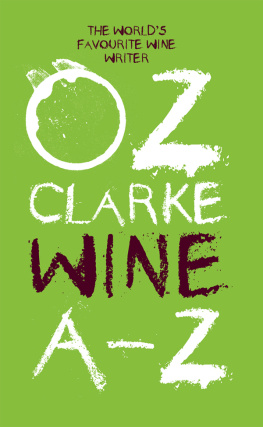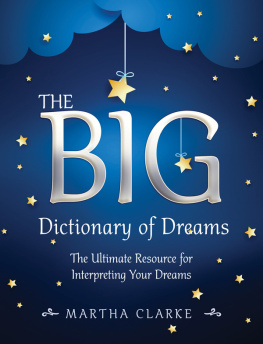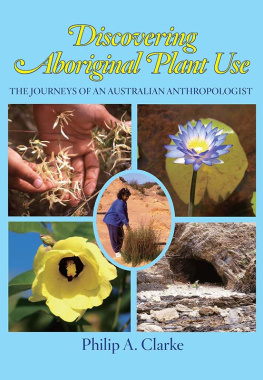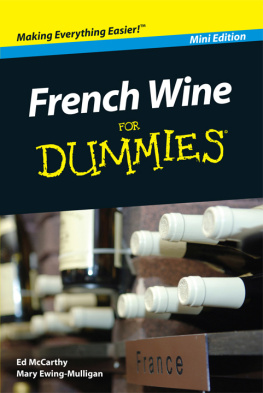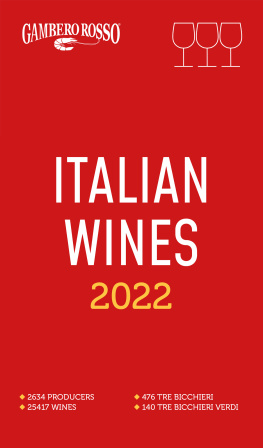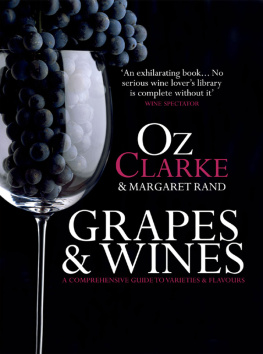
VINTAGE CHARTS

For selected older vintages, refer to the charts .
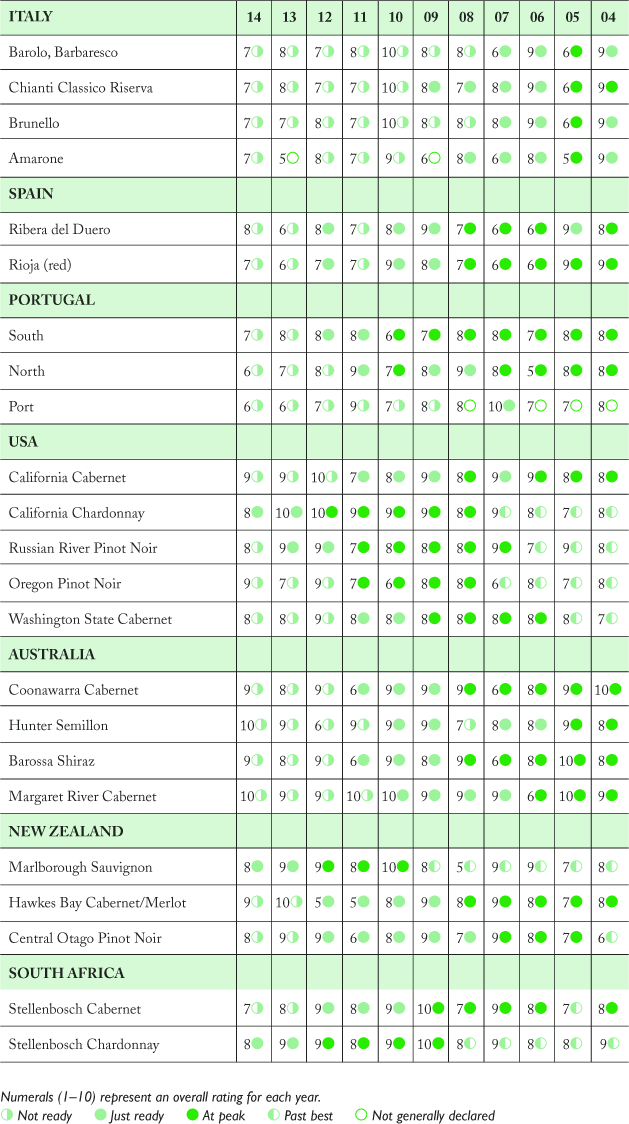

Grand old Grenache vines, their leaves just turning autumnal gold, caught at sunset in the Barossa Valley, South Australia.
CONTENTS
INTRODUCTION
Now, please dont say you havent noticed it. Im talking about the weather. Wherever you live, whatever you do, you must have noticed the weather is changing. And if youre a wine producer, you must be scratching your head and thinking: how can I plan ahead, how can I calculate risks and benefits, how can I invest, and what must I invest in? what grape varieties, which areas of the planet, what styles of wine will I be able to make? does it all have to change, will it change for good?
What do you do if youre a Californian wine producer? The weather is getting warmer, but theres less and less water available to irrigate your crops. The snow in the Sierra Nevada mountains is crucial in supplying the river flow that feeds your irrigation pumps. Yet youre down to 20% of the historic snow pack. The last three years have been the driest on record. If you water your garden, you can be fined $500. And if Los Angeles is running out of water theyve just banned restaurants from offering the usual free glass of water with meals unless you request it how long are they going to let you irrigate your vines before the sheriff knocks on your door with a summons? Some vineyards dont need to be told. Their irrigation dams are already dry and thats Napa and Sonoma Im talking about. Not the blistering Central Valley.
Its not just California. Some of Chiles most exciting wines have come from northern vineyards planted in the arid but wind-cooled river valleys up toward the Atacama Desert. Limar has established itself as one of Chiles leading regions. But its bone dry. If the river flow fails, the vineyards fail, and the snowmelt in the Andes is dwindling. And that means there is less and less of the water that makes vineyards possible in places like Elqui, Huasco and Limar. And if Argentina thinks it will be any luckier it wont be. Australia is regularly struggling with 40C days during the ripening season. A few days of that heat, and the grapes on the vine can never fully recover their poise and balance. The great mining centre of Broken Hill, New South Wales, is literally running out of water as its expertly managed system of water conservation has quite simply failed. Reservoirs emptying in Broken Hill might not seem to be relevant to Australian wine. Tell that to worried growers in the Riverina and the Riverland, where most of Australias commercial grapes are grown.

Wine producers in many parts of the world are worried by the lack of rainfall in their vineyards, none more so than those in northern Chile. This is a dry lake, high in the Elqui Valley, which would normally be full of meltwater from the Andes.
And the New Zealanders cant snigger behind their hands at the Aussies misfortune either. New Zealand got hit by drought in 2015. New Zealand! Cool, green, showery New Zealand! They had to turn the irrigation systems off in Marlborough because the usually powerful Wairau River aquifer was running out of puff and they, literally, had no idea what to do theyd never had a drought before. At least there it just means that everybody had a bit of a panic but then produced a much reduced crop, bringing supply shortages rather than devastation but what if it happens next year? And next?
So has Europe been any luckier? Depends where you live. South-east Spain was roasted by drought and heatwaves in 2014. Dont expect too much joy from their wines. France had its warmest year ever. It was on the front pages of all its newspapers except that the heat came in great swathes, but not always when it was wanted, like in the summer August was pretty dismal. Then a record-dry September and most of October saved an awful lot of growers, but thats if their grapes werent attacked by a new pest a Japanese fruit fly called Drosophila suzukii you couldnt make it up! and they produced some pretty decent wine. But the further north you went, the better it got. Britain had its driest September for 100 years. It needed it. August had been Britains eighth wettest on record. Its encouraging to note that seven of Britains warmest ever years have been since 2000. But so have four of the five wettest ever years. 2014 had what the Met Office called the most exceptional rainfall in 248 years. A warmer atmosphere holds more water. A warmer world, they said, will lead to more intense daily and hourly events. They rate weather events as severe, extreme and exceptional. The UK had exceptional in 2014 and, on the bright side, when southern England basks in what would be regarded as good high summer temperatures of over 26C during mid-April 2015, whats not to like? Wait till July and August. Or maybe ask the growers in Burgundys Cte de Beaune villages who revelled in their earliest ever rising of the sap in their vines, then saw hail destroy as much as 100% of some of their vineyards for the third year in a row. Growers in the Languedoc watched helplessly as 10,000 hectares of vines were savaged by hail. Global warming isnt all fun. No one, except growers in Yorkshire and Scotland, ever said it was.

The Elqui River as it traditionally appears fast-flowing and copious. Snowmelt in the Andes is dwindling and if the river flows fail, the vineyards in both Chile and Argentina will struggle to survive.

All wine producers fear summer hail, which can decimate a crop in only a few minutes. There wont be any wine from these grapes here in Bordeaux.
And in Europe beyond the Alps, in Austria, Hungary, Croatia and the rest, unprecedented September rains swamped their crops and made quality wine a rarity. Croatia hadnt seen autumn rains like that for 50 years. Climate change brings torrential rain along with the heat. And it brings cold. North-east America suffered some of its coldest ever winter weather, and in Michigan, the town of Hell froze over (I couldnt resist that).
Global warming isnt all fun. No one, except growers in Yorkshire and Scotland, ever said it was.
So are we all doomed? Will we have a wine world to enjoy in a generations time? And if so, how? Well, despite the threat of climate Armageddon that seems to hang in the air nowadays like the threat of thunder on a sultry summers afternoon, the wine world is reacting. Indeed, it is embarking on one of its great leaps forward, when change comes tumbling in idols fall and reputations shake, new blood will be given its head, new flavours will appear, even as older ones will reappear. At certain times you feel that it is the worst in wine that waxes and the finest that wanes. But not now. The wine world has been through a tough period. Global financial confusion and, in particular, cliff-hanging survival tactics in the Eurozone seem to have had the effect of concentrating the mind wonderfully. And as the world struggles out of a deeply worrying phase, one that has certainly tested the nerve of many wine producers and, indeed, seen some of them go to the wall, we seem to have sliced off much of the slack flesh that we tolerate in easy times and have emerged with a leaner, more honest and much more challenging and exciting world of wine.
Next page
